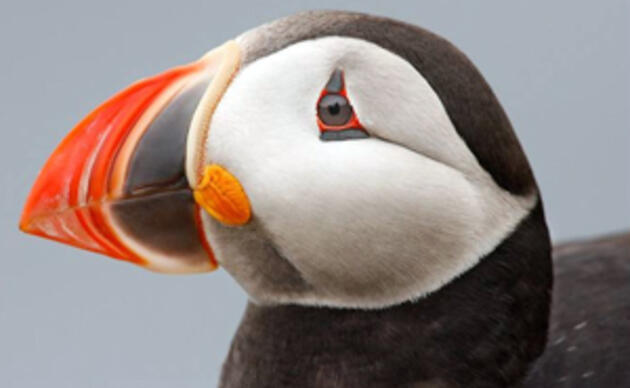The hatching of puffin chick “Conrad” this week provides an opportunity to reflect on the broader importance of this event. Conrad is one of about 500 puffin chicks presently living under the boulders of Seal Island National Wildlife Refuge. Their presence is a tribute to the effort to bring puffins back to this historic nesting colony—an action that was possible because of the dedication of the seabird stewards that live on the island each summer.
Puffling Conrad is named for Conrad Field, one of the first Seal Island “puffineers.” Conrad joined Project Puffin in 1985 and returned each summer through 1988. He helped build the first of the Seal Island sod puffin “condos” that housed nearly 1,000 puffin chicks translocated from Great Island, Newfoundland and fostered the week-old puffin chicks. He also defended the chicks from predatory Herring and Great Black-backed Gulls, which at the time dominated the northern part of Seal Island. Like many puffineers, Conrad has made a career of his passion for birds and is now a research biologist in Homer, Alaska.
When Project Puffin began, researchers were not talking about climate change. At the time, the Gulf of Maine was a relatively stable environment for puffins and other seabirds. Gulls were the biggest and most conspicuous threat. But now the current team of Seal Island seabird stewards, led by Keenan Yakola, are very much aware of the impact of climate change on this still-fragile colony. Keenan’s master’s thesis at University of Massachusetts Amherst focuses directly on the effects of climate on the fish and other marine life that terns and puffins eat. Unlike gulls, climate change is a much less conspicuous threat, and its impact on puffins and other seabirds could be missed if not for today’s team of puffineers who look for those effects.
It has also become increasingly clear that puffins are an excellent indicator of the impact of climate change on the Gulf of Maine. First, consider the puffin’s relatively massive egg. It is about the size of an extra-large chicken egg and comprises about 15% of the female’s body weight. Little wonder that they lay just one per year—on a good year. If there is not sufficient food for the female to create this impressive egg, she will skip breeding for the year. Hence the number of occupied burrows with incubating pairs is an annual measure of the state of puffins for the year. This year about two-thirds of the Seal Island puffin burrows contained an egg, which is about normal.
Because puffins are sensitive to disturbance while incubating, we do not weigh and measure either parents or eggs. However, in other species, clutch size, egg size and weight suggest adequate food supplies during egg development. An ample supply of the right kinds of fish for little Conrad and the other puffin chicks is now our main concern.
Happily, while visiting Seal Island this past week, I noted parent puffins returning to their nesting burrows with a steady stream of sand lance, white hake, and haddock for their pufflings. Likewise, puffin parents at nearby Matinicus Rock are finding similar foods so far this year. These bite-sized, easy-to-swallow fish are key to the growth of seabird chicks. The ample supplies suggest that the seas are sufficiently cool to favor the best food for puffins, terns, and other seabirds. Hopefully, these conditions will continue for at least another six weeks, giving Conrad and his fellow pufflings the chance to put on sufficient weight before heading to sea.
To watch the explore.org Puffin Burrow Cam, please click HERE.

Learn about birds and take action
Adopt-A-Puffin
Adopt now and receive a Certificate of Adoption, along with a biography of "your" puffin!
Visitor Center
The Project Puffin Visitor Center (PPVC) is located at 311 Main Street in downtown Rockland, Maine. The center opened its doors officially on July 1, 2006.



